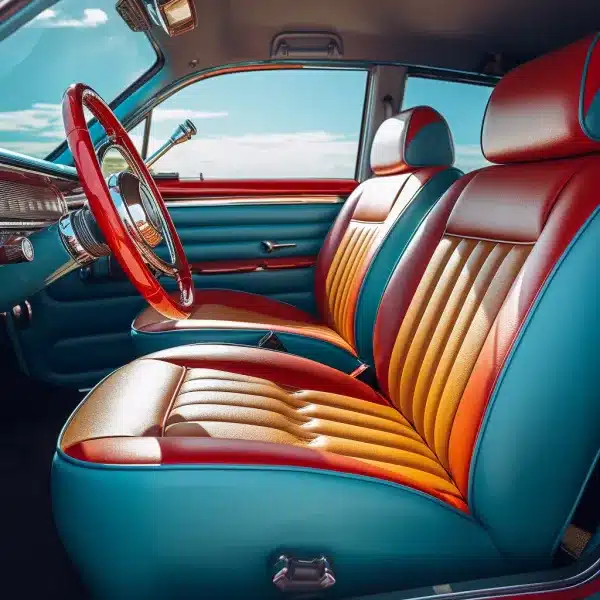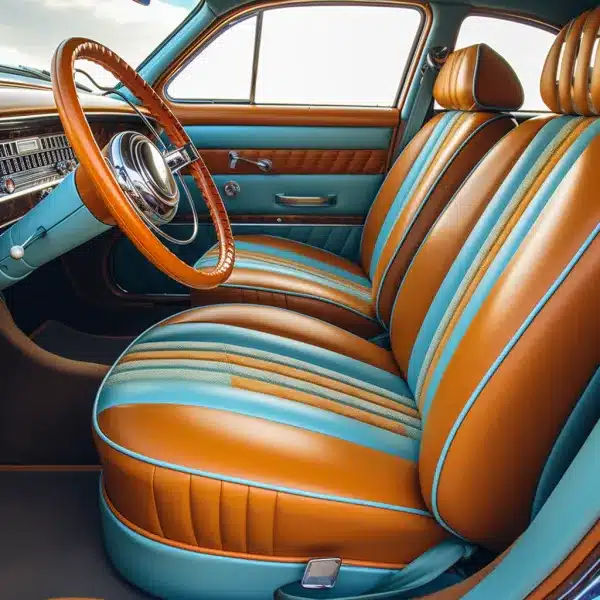
Mastering Car Upholstery: Essentials For Restoration Enthusiasts
Car Upholstery Basics: Car upholstery is an essential aspect of vehicle restoration, but it is often overlooked by many enthusiasts. Understanding the basics of car upholstery can empower car owners to tackle interior renewal projects on their own. While there are many techniques involved, having a grasp of the fundamentals can go a long way in achieving professional results. In this article, I will provide a comprehensive guide to mastering the basics of car upholstery, enabling you to breathe new life into your vehicle interior.

Key Takeaways
- Car upholstery is an important aspect of vehicle restoration.
- Understanding the basics empowers car enthusiasts to tackle upholstery tasks.
- Having the right tools is crucial for achieving professional results.
- Car upholstery techniques differ from furniture upholstery.
- Care and regular maintenance are essential for upholstery longevity.
Importance of Understanding Car Upholstery
When it comes to classic car restoration, upholstery is often a neglected aspect of the project. Many car enthusiasts focus on mechanical components like engine rebuilding and suspension while overlooking the importance of upholstery. However, mastering the basics of car upholstery is crucial for a complete and authentic restoration.
While pre-made upholstery kits are available for some car models, not all vehicles have this option. This means that enthusiasts may need to either reuse the original upholstery or attempt the project themselves. By understanding upholstery techniques and acquiring the necessary skills, car enthusiasts can expand their expertise and achieve true craftsmanship in their restorations.
One of the key tools for car upholstery is a sewing machine. A sewing machine designed for upholstery purposes allows for precise stitching and ensures the longevity of the upholstery. With the right sewing machine and knowledge of techniques such as pattern cutting and stitch selection, car enthusiasts can achieve professional-looking upholstery with ease.
“Upholstery is both an art and a science. It requires patience, precision, and creativity. By investing the time and effort into learning upholstery techniques, car enthusiasts can elevate their restorations to a whole new level.”
– Car Restoration Magazine
Importance of Upholstery Techniques
Understanding upholstery techniques is essential for achieving quality results in car restoration. From securing upholstery to shaping foam and removing wrinkles, each technique plays a vital role in creating a flawless interior. By delving into the world of upholstery, car enthusiasts can gain a deeper appreciation for the intricate craftsmanship that goes into restoring a vehicle’s interior.
With an understanding of the importance of car upholstery and the techniques involved, enthusiasts can embark on their restoration projects with confidence. By acquiring the necessary tools and knowledge, they can breathe new life into classic cars and create interiors that are both visually stunning and authentic to the vehicle’s era.
Essential Tools for Car Upholstery
When it comes to car upholstery, having the right tools is crucial to achieving professional results. Whether you’re a DIY enthusiast or a professional, investing in the following essential tools will make your upholstery projects much easier and ensure optimal outcomes.
Sewing Machine
An industrial sewing machine specifically designed for upholstery work is a must-have tool. These machines are powerful enough to stitch through thick upholstery fabrics and multiple layers, ensuring strong and durable seams.
Cutting Shears
To accurately cut upholstery materials, invest in a pair of cutting shears designed for this purpose. These shears have a longer blade length and serrated edges, allowing for clean, precise cuts without fraying the fabric.
Hog Ring Pliers
Attaching upholstery to the seat frame requires hog rings, and hog ring pliers are the tool for the job. These pliers make it easy to secure the upholstery to the frame tightly, ensuring a professional finish. They are designed with a special jaw that grips and closes the hog rings securely.
Industrial Steamer
An industrial steamer is an invaluable tool for shaping foam and removing wrinkles from upholstery fabrics. It produces a powerful jet of steam that can effectively mold foam into desired shapes and smooth out any creases or wrinkles in the fabric. This tool is especially useful for dealing with stubborn upholstery materials.
Staple Gun
A staple gun is essential for securing headliners and trim pieces in car upholstery projects. Look for a heavy-duty staple gun that can accommodate staples of various sizes. This tool allows for quick and secure attachment of fabric and trim, ensuring a neat and professional appearance.
These essential tools form the foundation of any car upholstery project and enable you to achieve high-quality results. Investing in quality tools will not only make your work easier but also contribute to the longevity and overall look of the upholstery.
Techniques and Tips for Car Upholstery
When it comes to securing upholstery in a car, there are specific techniques and tips that are essential to achieving professional results. One of the key components of car upholstery is the use of wire and listing. These materials are sewn to the bottom of the upholstery fabric and then attached to the seat frame using hog rings. This method ensures that the upholstery is securely fastened and will withstand the rigors of everyday use.
When working on car upholstery, it’s important to choose the right tools for the job. While some furniture upholstery tools may have overlapping uses, it’s best to invest in tools specifically designed for automotive upholstery. These tools are designed to handle the unique challenges of car upholstery, such as working with metal frames and securing upholstery to them. By using the proper tools, you can ensure a smooth and efficient process.
Tips for Successful Car Upholstery:
- Measure twice, cut once: Accurate measurements are crucial for a perfect fit.
- Take your time: Rushing through the process can lead to mistakes and subpar results.
- Choose high-quality materials: Opt for durable fabrics and foam that will stand the test of time.
- Practice proper stitching techniques: Consistent, straight stitches will enhance the finished look.
- Pay attention to details: Focus on correctly aligning patterns and ensuring smooth edges.
By following these techniques and tips, you can tackle car upholstery projects with confidence and achieve professional-quality results. Whether you’re restoring a classic car or simply refreshing the interior of your vehicle, mastering the art of car upholstery will add a touch of elegance and comfort to your ride.
| Wire and Listing | Benefits |
|---|---|
| Securely fastens upholstery | Prevents upholstery from shifting or sagging |
| Durable | Withstands regular use and wear |
| Allows for easy removal and replacement | Simplifies future repairs or upgrades |
Conclusion
Mastering the basics of car upholstery is essential for any car enthusiast or restorer looking to renew their vehicle’s interior. By understanding the fundamentals of car upholstery, enthusiasts can confidently tackle upholstery tasks and achieve professional results.
Having the right tools is crucial for successful car upholstery projects. Invest in essential tools like an industrial sewing machine, cutting shears designed for upholstery materials, hog ring pliers, an industrial steamer, and a staple gun. These tools form the foundation for any upholstery project and ensure optimal results.
When it comes to car upholstery, it’s important to learn the specific techniques and tips that differ from furniture upholstery. Secure upholstery using wire and listing, sewn to the bottom of the material and attached to the seat frame with hog rings. Choose tools specifically designed for automotive upholstery to achieve the best outcome.
Lastly, proper care and regular maintenance are crucial to preserve the longevity of car upholstery. Follow the guidelines and tips outlined in this article to ensure that your upholstery stays in good condition for years to come. By applying these car upholstery basics, using the right materials, and taking care of your upholstery, you can revitalize your vehicle’s interior and enjoy the satisfaction of a job well done.
FAQ
Why is car upholstery often overlooked in classic car restoration?
Car upholstery is often overlooked in classic car restoration because discussions typically revolve around mechanical aspects such as engine rebuilding and suspension. Upholstery is seen as an area best left to professionals or by using pre-made kits.
Can car upholstery be done by individuals without professional experience?
Yes, individuals without professional experience can tackle car upholstery projects. By understanding the basics and having the right tools, car enthusiasts can achieve professional results.
What are the essential tools for car upholstery?
The essential tools for car upholstery include an industrial sewing machine, cutting shears designed for upholstery materials, hog ring pliers, an industrial steamer, and a staple gun.
How does car upholstery differ from furniture upholstery?
Car upholstery differs from furniture upholstery in terms of the frames used and the techniques employed. Car upholstery utilizes metal frames with welded springs, while furniture upholstery typically uses webbing. Different tools may also be required for automotive upholstery.
How can car enthusiasts ensure the longevity of their upholstery?
To ensure the longevity of car upholstery, regular care and maintenance are important. This can include regular cleaning, avoiding direct sunlight exposure, and addressing any damages or wear promptly.

